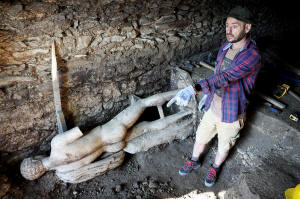|
The discovery of the 6.8-foot (2-metre) tall statue was made
during excavation work at the site of the ancient city of
Heraclea Sintica in southwestern Bulgaria, which lies close to
the Greek border.
Archaeologists leading the work said that after an earthquake
devastated the sprawling city in about A.D. 388, the statue had
been carefully placed in the sewers and covered with soil,
explaining its good condition.
"Its head is preserved. (It's in a) very good condition. There
are a few fractures on the hands," said Lyudmil Vagalinski, who
led the team of archaeologists, adding that the statue was a
Roman copy of an ancient Greek original.
Heraclea Sintica was a sprawling city founded by the ancient
Macedonian king Philip II of Macedon, between 356 B.C. and 339
B.C. in what is now the Bulgarian region of Pirin Macedonia.
Archaeologists say that the people of the Heraclea Sintica
likely attempted to preserve the statue, even after Christianity
was adopted as the official religion in the Roman Empire.
"Everything pagan was forbidden, and they have joined the new
ideology, but apparently they took care of their old deities,"
he said.
After the earthquake, the Heraclea Sintica fell into a rapid
decline and was abandoned by around A.D. 500.
(Writing by Aleksandar Vasovic; Reporting by Spasiyana Sergieva;
Editing by Helen Popper)
[© 2024 Thomson Reuters. All
rights reserved.]
Copyright 2022 Reuters. All rights reserved. This material may
not be published, broadcast, rewritten or redistributed.
Thompson Reuters is solely responsible for this content.

|
|





